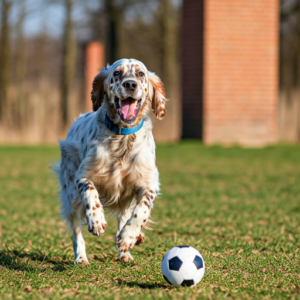Introduction to English Setters
The English Setter is a friendly, affectionate breed recognized by the American Kennel Club (AKC) as part of the sporting group. These dogs are renowned for their remarkable agility and grace, traits that made them exceptional hunting companions for centuries. As an active and energetic breed, English Setters thrive on play and exercise, particularly enjoying activities like swimming and fetch. With their keen sense of smell and a natural ability to locate game birds, English Setters are a favorite among hunters, but they also make delightful family pets. Known for their calm demeanor and affectionate nature, these dogs thrive in homes where they can enjoy both outdoor adventures and cozy indoor moments.
In this English Setter guide, we’ll explore the essential characteristics of the breed, their history, training tips, and health care needs. Whether you’re considering adopting an English Setter or you’re a new owner looking for helpful insights, this guide will equip you with the knowledge to care for and bond with this exceptional breed. It is also crucial to maintain a high-quality, balanced dog’s diet tailored to the specific needs of English Setters based on their age and health status.
Table of Contents
English Setter Characteristics
Friendly and Sociable Nature
The English Setter is a dog known for its friendly and sociable personality. They are affectionate with family members, gentle with children, and generally get along well with other dogs and pets. Their outgoing nature makes them great companions for households with multiple pets, and their easygoing temperament makes them well-suited for first-time dog owners.
Though typically calm around the home, these dogs have a high energy level that stems from their history as hunting dogs. They thrive on physical and mental stimulation, making them an excellent fit for active families and individuals who enjoy outdoor activities. Whether you’re going for a run, playing fetch in the park, or hiking through the woods, your English Setter will be eager to join you.

Size and Appearance
The English Setter is a medium-sized dog with an athletic, elegant build. Males typically stand between 25 and 27 inches tall at the shoulder, while females are slightly smaller, ranging from 23 to 25 inches. In terms of weight, males typically weigh between 65 and 80 pounds, while females range from 45 to 55 pounds. The English Setter’s athletic build and hunting abilities were enhanced by crossing old spaniel and pointer breeds.
One of the most distinctive features of the English Setter is its long, silky coat. Their beautiful feathering, especially on their tail, legs, and ears, gives them an air of elegance. Their coat is typically white with colorful markings, such as orange, black, or dark brown eyes or liver, though some have a speckled pattern. While their coat is a thing of beauty, it requires regular grooming to prevent tangles and mats. But the effort is well worth it, as a well-maintained coat enhances the breed’s charm.
History of English Setters as Hunting Dogs
The English Setter breed dates back over 400 years and has its origins in the hunting fields of England. Initially bred to locate and “set” (crouch or freeze) when game birds were nearby, the English Setter became an invaluable asset to hunters. Their ability to pinpoint game birds with remarkable precision, coupled with their natural instinct to remain steady, made them perfect partners for hunters in the field.
The breed’s name, “Setter,” is derived from this distinctive behavior. When the dog finds game, it “sets” by all four legs and crouching low to the ground, signaling the hunter to approach quietly. English Setters were developed by crossing old spaniel breeds with pointers, combining the flushing instinct of the spaniel with the pointer’s ability to freeze when game is spotted.
The English Setter’s hunting instincts were honed by breeders like Edward Laverack in the 19th century. Laverack is credited with refining the breed’s distinctive appearance and solidifying its temperament. His breeding program focused on creating a dog with both exceptional hunting abilities and a calm, affectionate personality.
In time, the English Setter made its way from the hunting fields of England to America, where it quickly became a favorite among hunters. Today, English Setters are cherished not only for their hunting prowess but also as devoted companions for families with small animals.
Caring for English Setters
Grooming and Coat Care
The English Setter‘s long, silky coat is one of its most iconic features, but it also requires regular care to stay healthy. Weekly grooming is essential to prevent mats and tangles, especially in areas like the ears, legs, and tail, where the feathering is most prominent. Using a slicker brush or a pin brush is ideal for detangling their coat, and you should make sure to check for any skin issues or parasites during grooming sessions.
Bathing should be done as needed—typically once every 6 to 8 weeks. Be sure to use a dog-friendly shampoo to keep their skin healthy. In addition to regular brushing and bathing, trimming around the ears, paws, and tail will help keep your English Setter’s coat looking its best.
Exercise Needs
English Setters are a high-energy and energetic breed that requires a significant amount of physical activity to stay happy and healthy. Their history as hunting dogs means they have a lot of stamina, and they enjoy activities like running, hiking, and swimming. It’s important to give your English Setter at least one hour of exercise each day to prevent boredom and ensure they remain physically fit.
In addition to walks, consider activities that engage your dog’s natural instincts, such as scent detection games or agility training. This will help keep them mentally stimulated and provide a more rewarding exercise experience. If you lead an active lifestyle, an English Setter will be a great companion for outdoor adventures like hiking or jogging.
While English Setters are energetic, they also have a calm and affectionate side. After a long day of play, they will be content to relax and cuddle with you indoors.
Training
Training an English Setter can be a highly rewarding experience. These dogs are intelligent, eager to please, and generally responsive to positive reinforcement methods like treats, praise, and play. They are relatively easy to train, especially when you make training sessions fun and engaging. However, because they were bred to be hunting dogs, they can sometimes get distracted by strong scents, so it’s important to keep training sessions consistent and focused.
The English Setter‘s gentle nature makes them an excellent choice for first-time dog owners. They respond well to kindness and patience, and their natural willingness to please makes them easy to manage. Additionally, regular socialization and exposure to new experiences will help your dog become well-rounded and confident in various situations.
Health Considerations
Like all dog breeds, English Setters are susceptible to certain health conditions. Common issues for this breed include hip dysplasia, elbow dysplasia, and progressive retinal atrophy (PRA). Regular veterinary check-ups, along with a healthy lifestyle, can help manage these conditions.
One of the most important aspects of English Setter health is maintaining a healthy weight. Obesity can exacerbate joint problems, so it’s crucial to monitor your dog’s diet and ensure they get enough exercise. Additionally, dental care is essential—regular brushing and professional cleanings will help keep your dog’s teeth in good condition.
Common Health Problems of English Setters
While English Setters are generally a healthy breed, they can be prone to certain health issues that owners should be aware of. One of the most common concerns is hip dysplasia, a genetic condition that affects the hip joint and can lead to arthritis and mobility problems. This condition can cause significant discomfort and may require medical intervention to manage.
Elbow dysplasia is another genetic issue that can affect English Setters, leading to similar arthritis and mobility challenges in the elbow joint. Regular veterinary check-ups and maintaining a healthy weight can help manage these conditions and improve your dog’s quality of life.
Eye problems are also relatively common in English Setters. Conditions such as cataracts, progressive retinal atrophy (PRA), and ectropion can affect their vision and overall eye health. Regular eye examinations by a veterinarian can help detect these issues early and provide appropriate treatment.
Allergies are another health concern for English Setters. They can suffer from skin allergies that cause itching, scratching, and sometimes skin infections. Identifying and managing the allergens, whether they are food-related or environmental, is crucial for keeping your dog comfortable.
Lastly, English Setters are at risk of developing certain types of cancer, such as lymphoma and mast cell tumors. Early detection and treatment are vital, so regular veterinary visits and monitoring for any other signs, unusual lumps or changes in your dog’s health are essential.
Working with a reputable breeder who prioritizes health testing and regular veterinary care can help mitigate these health concerns. A balanced diet, plenty of exercise, and preventive care are key to ensuring your English Setter lives a long, healthy life.
Diet and Nutrition
Maintaining a high-quality, balanced dog’s diet tailored to the specific needs of English Setters based on their age and health status is essential for their health and well-being. Opt for high-quality dog food that meets the breed’s specific needs. Look for foods that are rich in lean protein, healthy fats, and essential vitamins and minerals. For puppies, consider a large-breed puppy food to support their growth and development.
Adult English Setters should be fed twice a day, with appropriate portion sizes based on their age, activity level, and overall health. Be sure to measure your dog’s food to prevent overeating, which can lead to obesity. Always consult with your veterinarian for specific dietary recommendations and make adjustments as needed.

Positive Reinforcement Training
One of the best things about the English Setter is their ability to learn quickly, especially when training sessions are engaging and rewarding. Their love of praise and treats makes them highly responsive to positive reinforcement techniques. Whether you’re teaching basic commands like “sit” or more advanced tricks, rewarding them with a treat or a pat on the head will motivate them to repeat the behavior.
However, because English Setters are sensitive dogs, it’s important to keep training sessions gentle and supportive. They tend to take reprimands to heart, so using harsh corrections can negatively impact their confidence. A calm demeanor and gentle encouragement will help your English Setter feel comfortable and engaged in their training. The goal is to foster a trusting relationship, which will enhance both their learning and your bond.
Engaging Activities for Learning
English Setters are not only intelligent, but they also have an innate curiosity and a strong desire to please. This combination makes them excellent candidates for various dog sports and activities like obedience, agility, and rally. By engaging their minds in activities that challenge them, such as interactive puzzle toys or scent-based games, you’ll provide mental stimulation that can prevent boredom. Mental enrichment is crucial for the English Setter, as it keeps their sharp minds occupied and content.
Incorporating fun training exercises that tap into their natural hunting instincts, such as scent trails or hide-and-seek games, is a great way to keep your English Setter mentally stimulated while also developing their tracking abilities. These games align with their history as hunting dogs and give them a sense of purpose and excitement.
Socialization and Early Exposure
Socialization is key to ensuring that your English Setter grows up to be a well-adjusted adult dog. Like many breeds, English Setters benefit from early exposure to different people, environments, and other animals. Introducing your puppy to a variety of situations can help them become more confident and comfortable, reducing the likelihood of fear or aggression as they mature.
Puppy socialization classes are an excellent way to introduce your English Setter to new experiences in a controlled environment. These classes often involve meeting other puppies and learning how to interact appropriately with both people and animals. Additionally, taking your English Setter on supervised outings—whether it’s to a busy park, a pet store, or a friend’s house—can help them become adaptable to different environments. A well-socialized dog is more likely to be confident, friendly, and easy to manage in new social situations.
For the best results, start socializing your English Setter as early as possible. Between 3 and 14 weeks of age is an especially important window for exposing them to new experiences. Positive interactions during this period can shape your dog’s behavior and help prevent any future issues with fear or aggression. However, even after this critical period, it’s never too late to work on socialization—slow, patient exposure can help adult dogs overcome any challenges.
Because English Setters are generally friendly and sociable dogs, they tend to get along well with other pets. Early exposure to other dogs and animals will help your English Setter build positive relationships and adapt to living in a multi-pet household. It’s important to supervise these interactions, especially when introducing your Setter to new pets, to ensure that all parties feel safe and comfortable.
English Setter Puppies: Care and Development
Developmental Stages
When it comes to raising an English Setter puppy, moderation is key—especially when it comes to their daily exercise done. Puppies have developing bones and joints, so it’s important not to overdo it with activities that could strain their growing bodies. Until your English Setter is about two years old, focus on gentle exercises like controlled walks, supervised play in a secure area, and low-impact activities such as swimming.
Engaging your puppy in games that encourage their natural instincts—such as scent trails or light games of fetch—will help stimulate both their body and mind without risking injury. Additionally, avoid activities that involve hard impacts, such as jumping on hard surfaces, as these can strain their developing joints.
Training and Bonding
Puppyhood is the perfect time to start training your English Setter. Consistency and positive reinforcement are key to shaping their behavior during this time. As a sensitive breed, they respond best to praise, treats, and gentle encouragement. You’ll likely see them catch on to commands and house rules quickly due to their intelligence and eagerness to please.
Training sessions should be short, fun, and positive to maintain your puppy’s interest. Over time, you can gradually introduce more complex tasks and commands as your English Setter matures. Be sure to continue reinforcing good behavior and positive training with rewards, and remember that patience is essential.

English Setters as Family Pets
Gentle and Affectionate Companions
English Setters make fantastic family pets. Their gentle, affectionate nature and high intelligence make them wonderful companions for families of all sizes. These dogs are especially great with children due to their patient temperament, and they tend to get along with other pets as well, making them perfect for multi-pet households. An English Setter will eagerly join in on family activities, whether it’s playing in the backyard, taking walks, or cuddling on the couch after a long day.
Their playful nature and love of adventure mean they’re always up for a game of fetch or a trip to the park. But they also have a calm side, and they love nothing more than being close to their human family members. Whether you’re indoors or out, your English Setter will always be by your side, eager to share in your adventures.
Supervision with Children
While English Setters are generally good-natured, it’s important to supervise playtime, especially with younger children. Like all dogs, English Setters should be treated with respect and kindness. Children should be taught how to interact gently with dogs to prevent any accidental injuries. Although English Setters are patient, they are sensitive to rough handling, so guiding children on how to interact appropriately will ensure a positive experience for both the dog and the child.
With proper supervision and guidance, your English Setter can become a beloved member of the family, providing companionship and unconditional love.
Hunting with English Setters
English Setters have a rich history as hunting dogs, and their natural abilities make them exceptional in the field. With a strong prey drive and a keen sense of smell, they excel at flushing and retrieving game. If you’re interested in hunting with your English Setter, there are a few important steps to take.
Start with puppy training to socialize your young Setter to the sights and sounds of hunting. Basic obedience commands are essential, as they lay the foundation for more advanced training. Once your puppy is old enough, introduce them to the field gradually. Let them experience the thrill of the hunt in a controlled environment, allowing them to get used to the new smells and sounds.
Patience is key when training a hunting dog. It may take time for your English Setter to fully grasp the skills needed for hunting, so don’t get discouraged if progress seems slow. Consistent training and positive reinforcement will help your dog develop the necessary skills.
Safety should always be a priority when hunting with your English Setter. Ensure they are well-trained and responsive to commands to prevent accidents. Equip them with the necessary gear, such as a GPS collar, to keep track of their location in the field.
Hunting with an English Setter can be a rewarding experience, strengthening the bond between you and your dog while allowing them to fulfill their natural instincts.
Finding the Right English Setter
Responsible Breeders and Rescue Organizations
If you’re looking to add an English Setter to your family, consider adopting from a rescue organization or purchasing from a reputable breeder. The English Setter Association of America (ESAA) is an excellent resource for both purebred and rescue dogs, offering valuable information on the breed’s history, health considerations, and temperament.
When choosing a breeder, make sure to ask about health clearances and temperament testing. A responsible breeder will conduct health screenings for common breed-specific issues such as hip and elbow dysplasia and will provide documentation for these tests. This helps ensure you’re bringing home a healthy, well-adjusted puppy.
Rescue organizations are also a wonderful option, providing a second chance for English Setters in need of loving homes. Many rescues offer support and advice to help new owners transition their dogs into their homes smoothly.
Pet Care and Maintenance
Grooming and Exercise
To keep your English Setter looking and feeling their best, regular grooming is a must. Their long, silky coat requires consistent care, including brushing several times a week to prevent tangles and mats. Bathing every six weeks, along with trimming hair around the ears and paws, will keep them tidy and comfortable. Additionally, regular ear checks are important, as their floppy ears can be prone to infections.
Along with grooming, providing regular exercise is key to their well-being. English Setters are active and energetic, so daily walks, play sessions, and mental enrichment activities are necessary to prevent boredom and destructive behavior.
Pet Insurance for Your English Setter
As a responsible dog owner, considering pet insurance for your English Setter is a wise decision. Pet insurance can help cover the cost of veterinary care in the event of an accident or illness, providing peace of mind for you and your family.
When choosing a pet insurance policy for your English Setter, there are several other factors also to consider. Look for a policy that offers comprehensive coverage, including accidents, illnesses, and wellness care. This ensures that your dog is protected in various situations, from routine check-ups to emergency treatments.
Cost is another important factor. Compare different policies to find one that fits within your budget while still offering adequate coverage. Keep in mind that the cheapest option may not always provide the best protection, so balance cost with the level of coverage provided.
Pre-existing conditions can be a concern, especially for breeds like English Setters that are prone to certain health issues such as hip dysplasia or eye or skin problems too. Make sure the policy you choose covers these conditions to avoid unexpected expenses.
Some insurance providers offer breed-specific coverage, which can be beneficial for addressing common health concerns in English Setters. This specialized coverage can provide additional peace of mind, knowing that your dog’s specific needs are taken into account.
By investing in pet insurance, you can ensure that your English Setter receives the best possible care without the financial strain of unexpected veterinary bills. This allows you to focus on enjoying your time with your canine friend, knowing they are well-protected.
Conclusion
An English Setter makes a wonderful companion for families who can provide plenty of exercise, love, and attention. Their friendly, affectionate nature, combined with their intelligence and eagerness to please, make them an ideal pet for many households. By following the guidance provided in this English Setter guide, you can raise a healthy, happy, and well-adjusted dog that will bring joy to your family for many years to come.
Proper training, socialization, and care will ensure that your English Setter grows into a well-behaved and loving family member. Whether you’re embarking on outdoor adventures or enjoying quiet time at home, your English Setter will be a loyal and joyful companion every step of the way.



